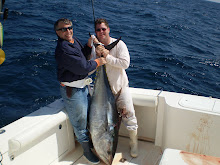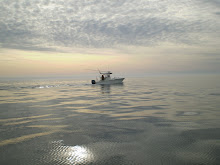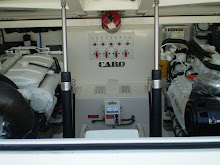 By Jim Field
By Jim FieldOne of the things I love about going offshore is coming across merchant ships and getting to see them in their element, sometimes relatively upclose. To state this right upfront: I think they are majestic, beautiful objects, something worthy of our full interest.
But we mostly ignore them. To be sure, we monitor their movement to ensure we stay sufficiently clear of their track. However, beyond this chore, once the inconvenience of dealing with them is over, at most we might give them a few passing glances, not really to look at them honestly, but because they happen to occupy, temporarily, the field of vision we're monitoring for signs of fish.
These ships, I'd argue, deserve respect and genuine attention, not our neglect. They are, after all, modern manifestations of generations of ships that have plyed the oceans for ages in pursuit of commercial gain and riches. They are transiting between ports located across the globe. They are registered under countless nations' flags and manned by crews of every race and nationality. They have seen and, as their presence attests, weathered all types of sea conditions.
We revere ships from prior ages--particularly from the Great Age of Sail--but we harbor no asthetic or romantic feeleings for the contemporary large ships among us. Is it that wood, canvas, and sleek lines are beautiful, but steel and functionality are not? Perhaps so, but I, for one, am fascinated by them.
First of all, their design follows directly from their function, i.e. what they're carrying: oil, natural gas, automobiles, containers, ores, etc. Upon close inspection, some are well-maintained and freshly painted, while others are rusting and look precarious. Under a full head of steam, the bows of some--like a knife-edge--cut through the water cleanly; others sport a bulbous nose, which is revealed to varying degrees, depending upon the ship's ballast. Interestingly, these spherical appendages are hollow, and have an interesting story. Years ago, the U.S. Navy experimented with placing sonar equipment in the bow of warships inside these enclosures in the hope of minimizing interfering noise caused by the ship's wake and movement through the water. They discovered, counter-intuitively, that instead of slowing the ship's speed, the sphere actually reduced water resistence and provided a boost. Thus, we see them today on commerical carriers to reduce transit times and increase fuel efficiency.
When I joined the U.S. Navy as a young man and served on my first submarine--with the rank of a lowly Seaman Recruit (one white strip on my uniform)--my first job when underway was serving as a helmsman and lookout. Transiting on the surface, the Officer of the Deck and two lookouts stood watch on the bridge, a tiny block of space perched on top of the vertical sail. As a lookout, your assignment--armed with a pair of 7x50 binoculars--was to constantly scan the horizon and sky for contacts of any kind. After a few months, lookouts became experts at this task, easily able to spot foreign objects under all conditions. We'd pick up ships "hull down," i.e., when the very tippy-top of their masts or houses first appeared on the horizon. Once identified and reported to the Officer of the Deck, we'd monitor them and see them take shape if we were on closing tracks. We'd study each ship, and sometimes log in its name, home port, and the markings on its stack, which typically displayed the shipping company's colors and logo.
No doubt my love and facination with merchant ships carries over from these days at sea. For me, they're every bit as beautiful, in their own right, as the Flying Cloud was in its day. Our era is Late Industrial, the clipper's was largely agricultural. In all liklihood, the next generation of ship afficienados will have paintings of our merchant ships on their mantlepieces, and speak of them in endearing terms. Why don't we fishermen today wake up to this living, oceangoing history that we encounter on nearly every trip, and take in this experience as something (almost) as special as catching grand fish?









No comments:
Post a Comment